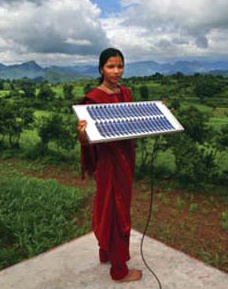CSE’s ‘Mini-grids: Electricity for All’ report believes there’s a lot of potential to be tapped in the North East
Currently, renewable energies like solar and wind have very little penetration in India’s north-eastern states — even though there is a huge potential to meet a majority of the region’s energy demand from solar, wind and small hydropower. Manipur is, in fact, the only state in the region that has a solar policy,” said Chandra Bhushan, deputy director general, Centre for Science and Environment (CSE), while opening a conference recently on ‘100 per cent renewable energy future for the Northeast’. CSE organized the one-and-half day conference to promote renewable energy in the region for energy access.
Of India’s 1.3 billion people, almost 240 million do not have access to electricity. The International Energy Agency has further projected that India will have 147 million people without electricity in 2030. At present, renewable energy in the northeast refers only to small hydro power (less than 25 megawatts – even though the region sits on potential reserves of almost 60,000 MW.
To add to this, the Northeastern states have one of the lowest per capita electricity consumption rates in the country: there are still roughly 4.85 million households – more than 50% in the region — that do not have access to electricity. In fact, the per capita electricity consumption in the region is as low as some of the least developed nations.
The situation is compounded by the fact that the current government schemes to provide electricity are primarily based on grid expansion. This model has so far not been able to provide electricity to the poor in the country, and may yet fail to do so.
It is in this context that CSE’s latest report ‘Mini-grids: Electricity for All’ assumes significance. The report was released and discussed at the event. The report presents a model centered on generation-based incentive and subsidy for setting up distribution infrastructure to ensure every household receives one unit of electricity every day. It is important to understand that the national grid and mini-grids would be complementary to each other.
Bhushan says: “The model presents a strategy to provide universal access of electricity using renewable energy based decentralized distributed generation / mini-grids. It will enable the north-eastern states to leapfrog to a new clean energy future. This will also ensure democratization of power generation.”
Agartala First Solar City in NE
Agartala, capital of Tripura, is all geared up to be Northeast’s first solar city. In 2012, 700 hamlets and 50 villages in remote areas were provided solar energy, benefiting more than 35,000 families, mostly tribals.
Of India’s 60 proposed solar cities, eight cities have been identified in the northeastern region by the ministry of on non-renewable energy (MNRE). They are Itanagar in Arunachal Pradesh, Agartala in Tripura, Guwahati and Jorhat in Assam, Aizawl in Mizoram, Imphal in Manipur and Kohima and Dimapur in Nagaland.










